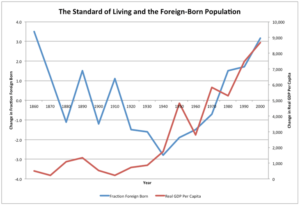Op-Ed
August 28, 2015
THE TRUE COST OF TRUMP’S IMMIGRATION PLAN
Donald Trump’s immigration policy proposal features tough rhetoric and a “plan” to finance a border fence. Putting aside the promise to make Mexico pay — a decidedly unrealistic proposition — a close examination of Trump’s proposal reveals two things: it is incredibly expensive; and it will not help American workers.
At its core, the proposal is an enforcement-only approach to immigration reform. A significant portion of the proposal is dedicated to increasing border security and interior enforcement — finishing the fence along the southwest border; tripling the number of U.S. Immigration Custom Enforcement (ICE) agents; nationwide employment verification; and mandatory detention of illegal border crossers. Trump also proposes tighter restrictions on the H-1B highly skilled worker visa program and a temporary suspension of legal immigration, neither of which is part of a pro-growth immigration reform.
The American Action Forum analyzed the costs of fully enforcing current immigration law and found that it would cost $400-600 billion to deport all the undocumented immigrants in the country and prevent all future unlawful immigration, a process that would take 20 years at current ICE staffing levels. It is likely that Trump’s exact plan would cost even more than our estimate, which did not account for expenditures like the thousands of additional detention beds that would be needed and the significant increase in the number of ICE agents.
Even bigger than the fiscal cost would be the economic devastation of such an approach. Full enforcement of current immigration law would decrease the labor force by approximately 6 percent and result in $1.6 trillion in lost GDP.
Supporters of the plan claim unemployed Americans would simply fill the jobs left vacant when 11 million workers are deported, but the reality is not that simple. Americans will not fill those vacancies because Americans and immigrant workers are not substitutes for each other’s labor. To the extent Americans compete with immigrants for jobs, the global economy ensures that they are competing whether the worker lives across the ocean or across the street.
Trump’s approach ignores the job creation potential of immigration, particularly of highly skilled immigrants and temporary workers. A study by Regional Economic Models, Inc. found that increasing the number of H-1B visas available to as many as 180,000 per year would create 1.3 million jobs by 2045. Hundreds of thousands of additional jobs are created when the caps on other temporary worker visas, such as agricultural and low skilled, are raised.
Suspending legal immigration in the short term will not help unemployed Americans, and would delay the positive economic benefits of immigration. The allotment of job-creating H-1B visas is exhausted in a matter of weeks every year. Immigrants seeking green cards currently face backlogs of several years. These hurdles encourage illegal immigration by making it extraordinarily difficult for foreign-born workers to legally enter the U.S. for jobs.
Trump is not unique in his distaste for illegal immigration — no thoughtful politician supports it. And everyone wants to help American workers. Unlike Trump’s approach, however, good immigration policy is good economic policy. A smart, skills-based immigration reform that allows more workers into the U.S. is the policy that can accomplish the aid to American workers that Trump’s plan will fail to deliver.
To view the article click here.










